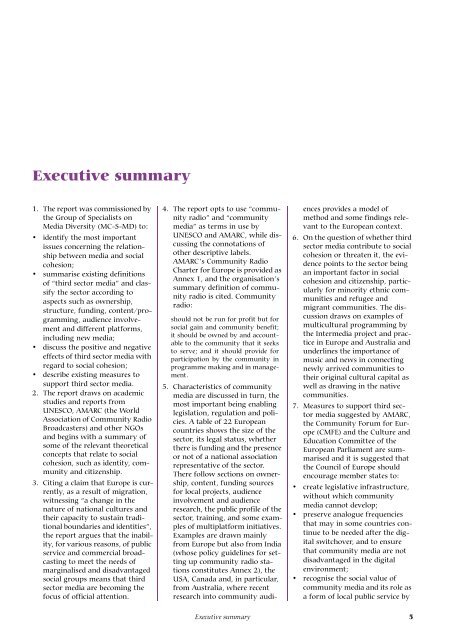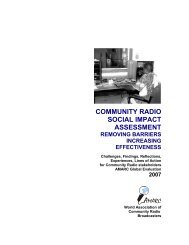Promoting social cohesion: the role of community media - amarc
Promoting social cohesion: the role of community media - amarc
Promoting social cohesion: the role of community media - amarc
- No tags were found...
Create successful ePaper yourself
Turn your PDF publications into a flip-book with our unique Google optimized e-Paper software.
Executive summary1. The report was commissioned by<strong>the</strong> Group <strong>of</strong> Specialists onMedia Diversity (MC-S-MD) to:• identify <strong>the</strong> most importantissues concerning <strong>the</strong> relationshipbetween <strong>media</strong> and <strong>social</strong><strong>cohesion</strong>;• summarise existing definitions<strong>of</strong> “third sector <strong>media</strong>” and classify<strong>the</strong> sector according toaspects such as ownership,structure, funding, content/programming,audience involvementand different platforms,including new <strong>media</strong>;• discuss <strong>the</strong> positive and negativeeffects <strong>of</strong> third sector <strong>media</strong> withregard to <strong>social</strong> <strong>cohesion</strong>;• describe existing measures tosupport third sector <strong>media</strong>.2. The report draws on academicstudies and reports fromUNESCO, AMARC (<strong>the</strong> WorldAssociation <strong>of</strong> Community RadioBroadcasters) and o<strong>the</strong>r NGOsand begins with a summary <strong>of</strong>some <strong>of</strong> <strong>the</strong> relevant <strong>the</strong>oreticalconcepts that relate to <strong>social</strong><strong>cohesion</strong>, such as identity, <strong>community</strong>and citizenship.3. Citing a claim that Europe is currently,as a result <strong>of</strong> migration,witnessing “a change in <strong>the</strong>nature <strong>of</strong> national cultures and<strong>the</strong>ir capacity to sustain traditionalboundaries and identities”,<strong>the</strong> report argues that <strong>the</strong> inability,for various reasons, <strong>of</strong> publicservice and commercial broadcastingto meet <strong>the</strong> needs <strong>of</strong>marginalised and disadvantaged<strong>social</strong> groups means that thirdsector <strong>media</strong> are becoming <strong>the</strong>focus <strong>of</strong> <strong>of</strong>ficial attention.4. The report opts to use “<strong>community</strong>radio” and “<strong>community</strong><strong>media</strong>” as terms in use byUNESCO and AMARC, while discussing<strong>the</strong> connotations <strong>of</strong>o<strong>the</strong>r descriptive labels.AMARC’s Community RadioCharter for Europe is provided asAnnex 1, and <strong>the</strong> organisation’ssummary definition <strong>of</strong> <strong>community</strong>radio is cited. Communityradio:should not be run for pr<strong>of</strong>it but for<strong>social</strong> gain and <strong>community</strong> benefit;it should be owned by and accountableto <strong>the</strong> <strong>community</strong> that it seeksto serve; and it should provide forparticipation by <strong>the</strong> <strong>community</strong> inprogramme making and in management.5. Characteristics <strong>of</strong> <strong>community</strong><strong>media</strong> are discussed in turn, <strong>the</strong>most important being enablinglegislation, regulation and policies.A table <strong>of</strong> 22 Europeancountries shows <strong>the</strong> size <strong>of</strong> <strong>the</strong>sector, its legal status, whe<strong>the</strong>r<strong>the</strong>re is funding and <strong>the</strong> presenceor not <strong>of</strong> a national associationrepresentative <strong>of</strong> <strong>the</strong> sector.There follow sections on ownership,content, funding sourcesfor local projects, audienceinvolvement and audienceresearch, <strong>the</strong> public pr<strong>of</strong>ile <strong>of</strong> <strong>the</strong>sector, training, and some examples<strong>of</strong> multiplatform initiatives.Examples are drawn mainlyfrom Europe but also from India(whose policy guidelines for settingup <strong>community</strong> radio stationsconstitutes Annex 2), <strong>the</strong>USA, Canada and, in particular,from Australia, where recentresearch into <strong>community</strong> audiencesprovides a model <strong>of</strong>method and some findings relevantto <strong>the</strong> European context.6. On <strong>the</strong> question <strong>of</strong> whe<strong>the</strong>r thirdsector <strong>media</strong> contribute to <strong>social</strong><strong>cohesion</strong> or threaten it, <strong>the</strong> evidencepoints to <strong>the</strong> sector beingan important factor in <strong>social</strong><strong>cohesion</strong> and citizenship, particularlyfor minority ethnic communitiesand refugee andmigrant communities. The discussiondraws on examples <strong>of</strong>multicultural programming by<strong>the</strong> Inter<strong>media</strong> project and practicein Europe and Australia andunderlines <strong>the</strong> importance <strong>of</strong>music and news in connectingnewly arrived communities to<strong>the</strong>ir original cultural capital aswell as drawing in <strong>the</strong> nativecommunities.7. Measures to support third sector<strong>media</strong> suggested by AMARC,<strong>the</strong> Community Forum for Europe(CMFE) and <strong>the</strong> Culture andEducation Committee <strong>of</strong> <strong>the</strong>European Parliament are summarisedand it is suggested that<strong>the</strong> Council <strong>of</strong> Europe shouldencourage member states to:• create legislative infrastructure,without which <strong>community</strong><strong>media</strong> cannot develop;• preserve analogue frequenciesthat may in some countries continueto be needed after <strong>the</strong> digitalswitchover, and to ensurethat <strong>community</strong> <strong>media</strong> are notdisadvantaged in <strong>the</strong> digitalenvironment;• recognise <strong>the</strong> <strong>social</strong> value <strong>of</strong><strong>community</strong> <strong>media</strong> and its <strong>role</strong> asa form <strong>of</strong> local public service byExecutive summary 5
















